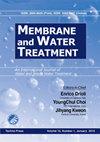Treatment of highly polluted grey waters using Fenton, UV/H2O2 and UV/TiO2 processes
IF 1.1
4区 工程技术
Q4 ENGINEERING, CHEMICAL
引用次数: 1
Abstract
Household or office wastewater consists of two parts of faecal and non-faecal wastewater. Non-faecal section, which accounts for more than 60% of household wastewater, is known as grey water. Treating this part of sewage and using it in various areas can greatly reduce the consumption of potable water. In this research, three methods of advanced oxidation processes including Fenton, UV/H2O2, and UV/TiO2 were investigated for treatment of two grey water sourced from Shif Island and Persian Gulf University restaurant in Bushehr province of Iran. These grey waters were highly polluted with COD content of 600 mg/L and 1400 mg/L, respectively. The efficiency of each process was determined by measuring the COD removal rate. Results showed that at optimum reaction conditions, the COD removal efficiency of the UV/H2O2 process was the best, compared to the other two processes. The COD removal efficiency of UV/H2O2 process at pH = 3 and H2O2 = 1500 and 750 mg/L for grey water of the Shif Island and Persian Gulf University restaurant were 88% and 90%, respectively. Therefore, the treated gray waters can be reused economically.Fenton、UV/H2O2和UV/TiO2工艺处理高污染灰水
家庭或办公室废水由粪便废水和非粪便废水两部分组成。非粪便部分占家庭废水的60%以上,被称为灰水。处理这部分污水并将其用于各个地区可以大大减少饮用水的消耗。本研究采用Fenton、UV/H2O2和UV/TiO2三种先进氧化工艺处理伊朗布什尔省Shif岛和波斯湾大学餐厅的两种灰水。这些灰色水域受到严重污染,COD含量分别为600 mg/L和1400 mg/L。通过测量COD去除率来确定每个工艺的效率。结果表明,在最佳反应条件下,UV/H2O2工艺对COD的去除效果最好。在pH=3、H2O2=1500和750mg/L条件下,UV/H2O2工艺对Shif Island和波斯湾大学餐厅灰水的COD去除率分别为88%和90%。因此,处理后的灰水可以经济地重复使用。
本文章由计算机程序翻译,如有差异,请以英文原文为准。
求助全文
约1分钟内获得全文
求助全文
来源期刊

Membrane Water Treatment
ENGINEERING, CHEMICAL-WATER RESOURCES
CiteScore
1.90
自引率
30.00%
发文量
0
审稿时长
>12 weeks
期刊介绍:
The Membrane and Water Treatment(MWT), An International Journal, aims at opening an access to the valuable source of technical information and providing an excellent publication channel for the global community of researchers in Membrane and Water Treatment related area. Specific emphasis of the journal may include but not limited to; the engineering and scientific aspects of understanding the basic mechanisms and applying membranes for water and waste water treatment, such as transport phenomena, surface characteristics, fouling, scaling, desalination, membrane bioreactors, water reuse, and system optimization.
 求助内容:
求助内容: 应助结果提醒方式:
应助结果提醒方式:


